Hi Charlie - here is a selection of driver and room measurement screenshots made with the Deqx software. The first 4 are initial (pre-calibration) driver measurements, the 5th is a calibrated sub (not sure why I included that), and the remaining 3 are room measurements after calibration. I think the filenames are descriptive enough - if not just ask
On second thoughts they probably do need some explanation - the 1st is the fullrange with tweeter biamped and both crossed-over at 2.5khz, mic aimed midway between them. The 2nd is fullrange crossed-over at 12.4khz and tweeter crossed-over at same by capacitor/resistor. The 3rd is fullrange driver only with mic aimed midway between fullrange and tweeter. The 4th is fullrange driver only, with mic aimed at whizzer. The 5th is a calibrated sub (one of a pair). The remaining 3 room measurements probably don't need elaboration
On second thoughts they probably do need some explanation - the 1st is the fullrange with tweeter biamped and both crossed-over at 2.5khz, mic aimed midway between them. The 2nd is fullrange crossed-over at 12.4khz and tweeter crossed-over at same by capacitor/resistor. The 3rd is fullrange driver only with mic aimed midway between fullrange and tweeter. The 4th is fullrange driver only, with mic aimed at whizzer. The 5th is a calibrated sub (one of a pair). The remaining 3 room measurements probably don't need elaboration
Attachments
-
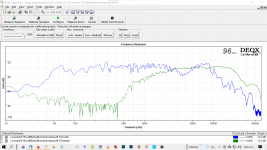 BetsyBiampYamahaLeft1st.png206.4 KB · Views: 156
BetsyBiampYamahaLeft1st.png206.4 KB · Views: 156 -
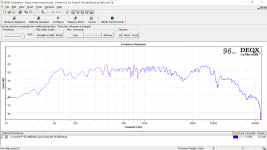 BetsyCapacitor12.4KhzLeftFullRange1st.png128.2 KB · Views: 156
BetsyCapacitor12.4KhzLeftFullRange1st.png128.2 KB · Views: 156 -
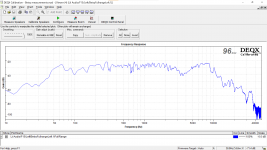 BetsyFullrangeLeft(BetweenDrivers)1st.png127.5 KB · Views: 157
BetsyFullrangeLeft(BetweenDrivers)1st.png127.5 KB · Views: 157 -
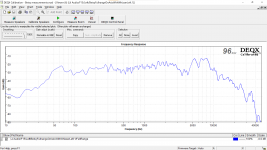 BetsyFullrangeOnAxisWithWhizzerLeft1st.png134.8 KB · Views: 157
BetsyFullrangeOnAxisWithWhizzerLeft1st.png134.8 KB · Views: 157 -
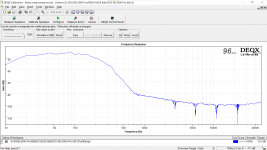 SVS SB-2000 Pro leftCalibrated.png128 KB · Views: 143
SVS SB-2000 Pro leftCalibrated.png128 KB · Views: 143 -
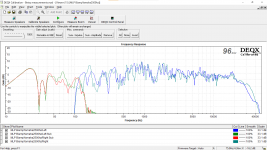 MLP BiampYamaha2500hz.png161 KB · Views: 68
MLP BiampYamaha2500hz.png161 KB · Views: 68 -
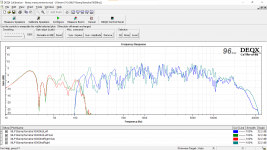 MLP BiampYamaha10000hz.png158.7 KB · Views: 65
MLP BiampYamaha10000hz.png158.7 KB · Views: 65 -
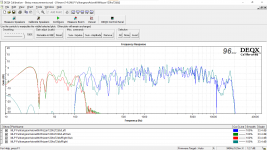 MLP FullrangeonAxiswithWhizzer120hz72db.png167.8 KB · Views: 70
MLP FullrangeonAxiswithWhizzer120hz72db.png167.8 KB · Views: 70
Last edited:
These are all "in room" measurements? Would it be possible to change the scaling on the plot to be something like 6-10dB/division? This will show you better how to match levels. For example in the first plot it doesn't appear that the tweeter or the fullranger are crossed over at all, but this might just be the scaling. It's very difficult to tell. Also, in the 6th plot "mlp-biamyamaha2500Hz" which I guess is the system response (both drivers on) it looks like the tweeter level is down by 5dB WRT the fullranger. Another observation is that the fullranger seems on average to be "too hot" between 600Hz and 2kHz in this plot. That might be due to too little correction for the fullranger for the dipole baffle losses at lower frequencies or the dipole peak. The speaker might sound irritating and bright unless the response is flattened to compensate for the open baffle type response features.
With a fullranger plus a sub plus a tweeter you have the makings of a 3-way system. I think you will get much better results if you were to design it properly as a system from the get go. You can still use the drivers you have, but do proper measurements FIRST and then a design a crossover from those. I would not use the DEQX for that purpose - it is not that kind of measurement tool nor is it a proper crossover. It's more a room correction tool plus preamp, etc. for speakers that already have a proper working crossover.
You wrote this earlier:
You mentioned this:
With a fullranger plus a sub plus a tweeter you have the makings of a 3-way system. I think you will get much better results if you were to design it properly as a system from the get go. You can still use the drivers you have, but do proper measurements FIRST and then a design a crossover from those. I would not use the DEQX for that purpose - it is not that kind of measurement tool nor is it a proper crossover. It's more a room correction tool plus preamp, etc. for speakers that already have a proper working crossover.
You wrote this earlier:
This seems to be testing out the various options you have at your disposal, but none of them are design-driven. There is only a finite chance that any one of these will work out well. It's a bit of a crapshoot, doing speaker design like this, to be brutally honest. You might get lucky, or you might not.I've tried the tweeter in several configurations - using the Deqx as active crossover and powering the tweeters with either the Tripath or Yamaha amp, at crossover frequencies of 2.5khz, 6khz, 10khz, and 12khz. I've tried with and without Deqx calibration, and with and without DSP correction. I've also tried using a resistor & capacitor crossover (@ 12400hz) - both via the Deqx, and directly through the tube amp without the Deqx. I've also tried using just the full-range driver on its own, both via the Deqx and directly through the amp.
You mentioned this:
In this case you have unleashed the DEQX on a speaker system, so there is a chance that it will be able to work its magic and get things sounding good. The speaker system is simply the fullranger itself. If that is OK sounding to you then this might be the best option if you do not want to do speaker design with the tweeter and sub as a system. I am not sure if the DEQX is able to flatten out the frequency response problems of your fullranger-in-baffle or not, but I would pay attention to the 500-2k Hz range, the bass drop off I mentioned earlier, and the falling response above 10kHz as areas that could use some improvement.My preferred configuration so far is to just use the full-range drivers without the tweeters, via the Deqx, using the Deqx's calibration & correction, crossover, group delay, and DSP capabilities.
Yes they're all in-room measurements - the weather's been too Springy/**** for outdoor measurements. By the number and nature of your questions I'd hazard a guess that I'm wasting your time unless I do quite a bit of 'due diligence' in learning about speaker design/measurement/calibration. Maybe I'll be back in 6 months, if I don't find the steepness of the curve too much for my geriatric brain ;-)
Yes they're all in-room measurements - the weather's been too Springy/**** for outdoor measurements. By the number and nature of your questions I'd hazard a guess that I'm wasting your time unless I do quite a bit of 'due diligence' in learning about speaker design/measurement/calibration. Maybe I'll be back in 6 months, if I don't find the steepness of the curve too much for my geriatric brain ;-)
You *can* do indoor measurements using a gated impulse technique to obtain the loudspeaker response independent of the room. This helps you get a much clearer picture of what the loudspeaker is doing and will be independent of position, e.g. quasi-fre-field as long as you gate out any room reflections. This is usually a manual task, so I don't think your DEQX is doing that kind of measurement but is more like a continuous signal RTA. That is not a good way to understand the loudspeaker but works for room response EQ measurements.
There is no "wasting of time" about my replies, i just wanted to make you aware of the many shortcomings of your approach. You are kind of putting the cart before the horse by relying on the DEQX. Also I mentioned that it may be just fine to use only the OB without the tweeter but you should try to correct its response before you bring the DEQX into the picture to do some final filligree.